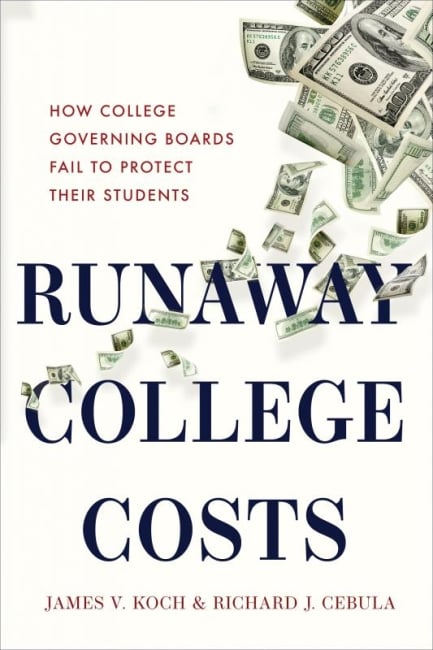You have /5 articles left.
Sign up for a free account or log in.

Johns Hopkins University Press
Few topics reliably inspire more disagreements within higher education than the cost of college -- whether it’s rising too fast, why it’s rising, whether the right people end up paying the bulk of increased costs.
New to the discussion is a book out last month, Runaway College Costs (Johns Hopkins University Press). Both of its authors are economists. One, James V. Koch, is an emeritus economics professor and president emeritus at Old Dominion University. The other, Richard J. Cebula, is affiliate research professor in the economics department at George Mason University and visiting professor in the economics department at Emory University. (This article has been updated with Richard J. Cebula's current position.)
Koch and Cebula turn their discussion about college costs toward boards of trustees and public colleges and universities. They argue trustees are charged with representing the interests of students, parents and taxpayers. Too often, in their view, the buck hasn’t stopped with trustees, who fail to hold the line on unnecessary spending and instead endorse the chase for prestige and rankings.
The results, they write, can be felt across the country and in all walks of life.
“Through decision and inattention, governing boards have contributed to the stratification of individual campuses and American society,” they write in the book. “Only in a few instances do we believe this strategy to have been deliberate. But deliberate or not, the end result was significant -- stratification on the basis of income, vastly increased student debt, and reductions in social and economic mobility. That’s a recipe for institutional and societal failure.”
Koch and Cebula bring data to back up their perspective. The typical nonsupervisory worker needed to work on average 224 hours to pay average annual tuition and fees at a four-year public institution in 1999-2000, they write. Eighteen years later, the typical nonsupervisory worker had to work 446 hours.
“One can almost see the ideal of American social mobility evaporating into the ether,” they write.
They also present evidence showing that governing board structure, membership and size can affect tuition and fees. For instance, they find that strong statewide governing boards place downward pressure on tuition and fees.
The authors jointly answered questions about their book via email. The following exchange has been lightly edited for length and clarity.
Q: Why focus on governing boards?
A: Governing boards must approve any cost increase of consequence, and they usually do so with unanimous votes. Nevertheless, their role and complicity largely has been ignored.
Q: You focus on public institutions, but they compete with private institutions in many cases for students, tax dollars and public subsidies. Why is it fair to look at public institutions when wealthy privates might be providing competitive pressure -- or at least air cover -- for the relentless search for higher revenues?
A: Two reasons. First, more data are available for public institutions than for independent institutions, who can choose not to disclose data and votes. Second, there are more public policy levers that can be utilized to influence public institutions. Thus, chances of change and reform are greater in the public sector.
Q: You mention rising administrative costs versus instructional costs. But college leaders often retort that they’re being asked to provide additional important student services, like mental health services for students. Is there an argument to be made that they are just responding to student needs or demand?
A: This is a legitimate complaint. However, inflation-adjusted administrative costs have risen significantly in recent years. We have a sample of almost 200 four-year public universities. Between fiscal year 2005 and fiscal year 2018, the institutional support expenses of these institutions rose 2.1 percent faster on an annual basis than the Consumer Price Index. It is doubtful that federal regulatory requirements account for all this.
Q: In recent years, some data have shown a slowing or even reversing of rising tuition revenue at many institutions. Could the market be balancing itself out over time?
A: Yes, but even before COVID-19, economic forces were at work disciplining many institutions of higher education. After all, head-count college enrollment nationally has fallen nine years in a row.
COVID-19 has accelerated change. Some flagship public universities with strong reputations may not need to worry about the size of their student bodies, but at least three-quarters of all public institutions now are at risk. Among the most vulnerable are regional institutions, those located in rural areas, those that have not mastered distance learning processes and [historically Black colleges and universities].
Q: You list many price control options: prune the curriculum, control amenities, monitor enrollments and class sizes, control administrative expenditures. Can anyone but governing board members put such controls in place?
A: Properly understanding and motivated governing boards both set the stage for these things to occur and ultimately approve them. Ideally, such changes are not imposed top down. Faculty and staff must understand, however, that their world is mutating before their very eyes, and they are well advised to discuss, develop and support intelligent changes before less precise solutions are imposed upon them.
Q: Interestingly, you include among possible solutions reforming accreditation. Are accreditor choices the bigger problem, or is it the three-legged stool of accreditors, state regulators and federal regulators itself?
A: At first glance, accreditation of university programs in the United States appears to be controlled by regional and disciplinary accrediting bodies. However, both federal and state government agencies play extensive roles in the accrediting process by virtue of laws, regulations and funding. This means that refashioning accrediting bodies will not by itself solve the problem. Joint action is required, and this will be very difficult to achieve. A first step, however, is to reorient accrediting bodies away from their frequent emphasis upon counting inputs and toward an evaluation of the educational outputs of institutions even years after students have graduated.
Q: What did we miss?
A: Access and affordability. It is unfortunate that many of our most prestigious public universities now accentuate economic inequality rather than reduce it. [In contrast], consider the good work of the University of California campuses in this regard, whose undergraduate Pell Grant percentages ranged from 23 percent (UC Berkeley) to 51 percent (UC Riverside) in 2018-19. This is hardly accidental; they have made it priority to do so.




